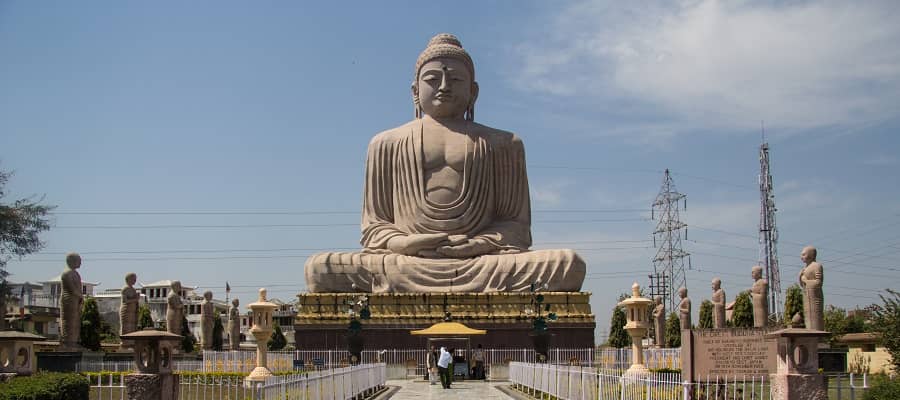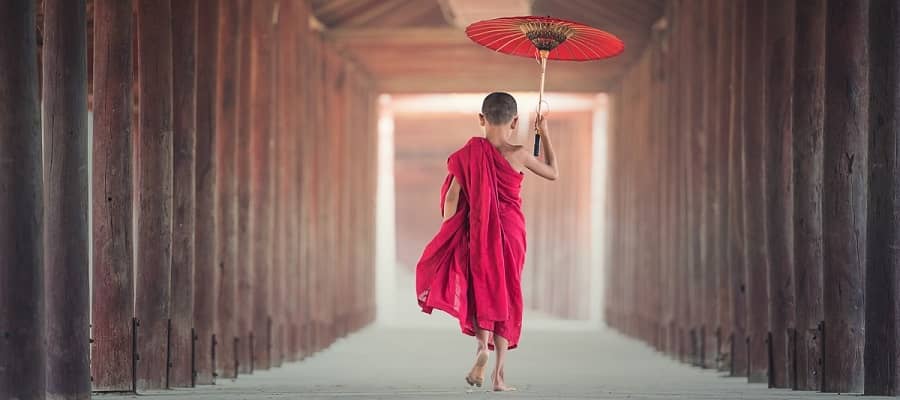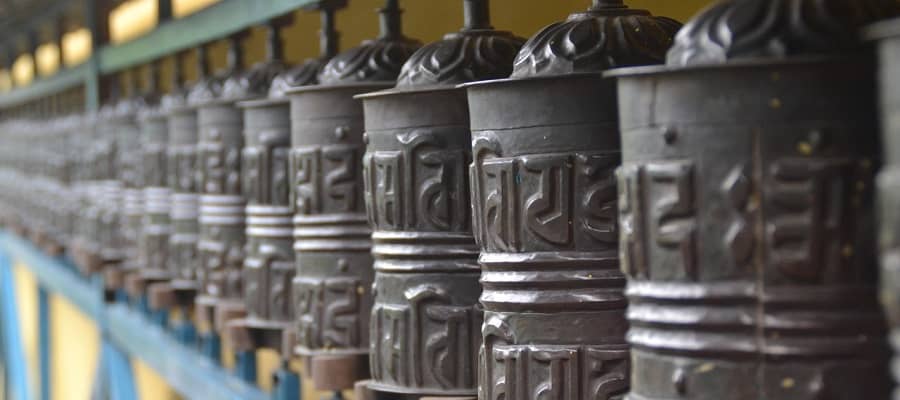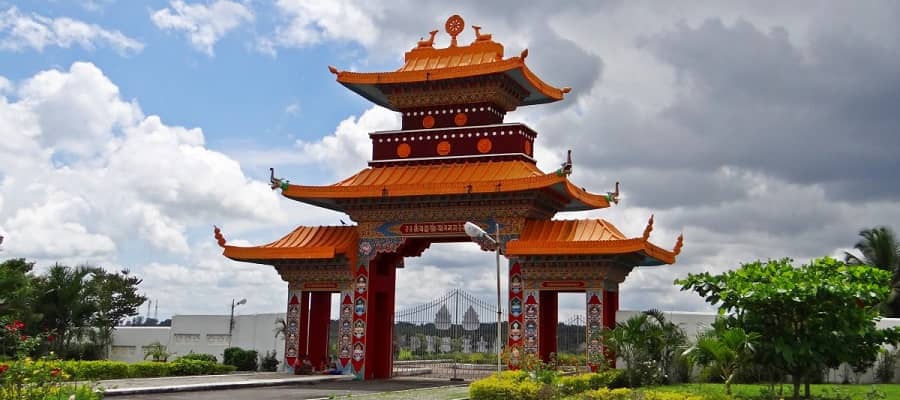Contents
buddhism beliefs four noble truths Buddhist Texts life of buddha
- Gautam Buddha was born as Prince Siddhartha at Lumbini near Kapilavastu (in present Nepal) in 563 BC.
- He was the son of Suddhodhana and Mahamaya.
- Suddhodhana was the chief of the Sakya clan (gana).
- Due to this, the Gautam Buddha was also known as ‘Sakyamuni’.
- His mother died either giving birth to him or after seven days.
- Siddhartha was brought up by his maternal aunt, Prajapati Gautami.
- This gave him the name ‘Gautama’.
>>>>>>>>

>>>>>>>>
- Gautam Buddha was married to Yashodhara and had a son, Rahula.
- He left his home at the age of 29 to become an ascetic.
- This event is called Mahabhishkramana.
- The idea of renunciation occurred to the Buddha after he saw four different states of man – sick man, old man, a corpse and an ascetic.
- Gautam Buddha wandered for seven years and at the age of 35 attained enlightenment at Uruvela while meditating under a banyan tree on the banks of the river Niranjana.
- This tree came to be known as ‘Bodhi tree’ and the place became Bodh Gaya (in Bihar).
- Gautam Buddha gave his first sermon at Sarnath near Varanasi.
- This event is called Dharmachakra Pravartana / Dhammachakkappavattana.
- Gautam Buddha died in 483 BC under a Sal tree in Kushinagar (in UP).
- This event is called Mahaparinirvana.
- The term ‘Buddha’ means ‘enlightened one’.
- Important contemporaries of the Buddha were Mahavira Jaina, Kings Prasenjit, Bimbisara and Ajatasatru.
>>>>>>>>
>>>>>>>
5 Events of Buddha’s Life
| Events | Year (BC) | Place | Symbol | |
|---|---|---|---|---|
| Birth | 563 | Lumbini | Lotus & Bull | Purnima |
| Renunciation or Great Departure or Mahabhinishkramana | Horse | |||
| Enlightment or Nirvana | Bodh Gaya | Bodhi Tree | Purnima | |
| First Sermon or Dhammachakraparivartan | Sarnath | Wheel | ||
| Death or Parinirvana | 483 | Kushinagar | Stupa | Purnima |
>>>>>>>>
>>>>>>>>>>
Three Jewels – Triratnas
- Buddha (the enlightened)
- Dhamma (doctrine)
- Sangha (order)
>>>>>>>>
>>>>>>>>>>
Four Noble truths (Arya Satya)
- Dukkha (the world is full of sorrow)
- Dukkha Samuddaya (that causes the sorrow)
- Dukkha Nirodha (sorrow can be stopped)
- Dukkha Nirodhagamini-pratipada (the path leading to the cessation of sorrow)
- The ultimate aim of life is to attain Nirvana, which means freedom, from further birth and death.
- Nirvana is the eternal state of peace and bliss or liberation from the cycle of birth and death
- Gautam Buddha had summarized the whole process in three words
- Seela (Right conduct),
- Samadhi (Right concentration)
- Prajna (Right knowledge).
- According to Gautam Buddha, Seela and Samadhi lead to Prajna, which is the direct cause of nirvana.
- Gautam Buddha advocated “The Middle Path” in which extremes are avoided.
- Gautam Buddha visited to the Deer Park (modern Sarnath), Kasi after his enlightenment and gave his first Sermon (lecture).
- His first sermon was known as “Set in Motion, the Wheel of Law”.
>>>>>>>>

>>>>>>>
Buddhist Councils
1st Council
- Conducted under the patronage of King Ajatasatru of Haryanka dynasty.
- It was held in 483 BC just after Buddha’s demise.
- It was held in Sattapani caves (Sattaparnaguha) in Rajagriha.
- A monk who presided over the first council was Mahakassapa.
- The main objective was to preserve the Buddha’s teachings.
- At this council, Ananda composed the Suttapitaka (Buddha’s Teachings)
- Mahakassapa composed the Vinaypitaka (monastic code).
>>>>>>>>>>
2nd Council
- Conducted under the patronage of King Kalasoka of Sisunaga dynasty.
- It was held in 383 BC, 100 years after the Buddha’s death.
- It was held at Vaishali.
- 2nd council was presided over by Sabakami.
- The main objective was to discuss ten disputed points under the Vinaypitaka.
- Major split happened here – two groups that would later evolve into Theravada and Mahayana.
- The first group was called Thera (meaning Elder in Pali). They wanted to preserve the teachings of Gautam Buddha in the original spirit.
- The other group called Mahasanghika (Great Community) interpreted the Buddha’s teachings more liberally.
>>>>>>>>>>
3rd Council
- Conducted under the patronage of Emperor Ashoka of Maurya dynasty.
- It was held in 250 BC at Pataliputra.
- Mogaliputta Tissa presided over the council.
- Main objective was to purify Buddhism from opportunistic factions and corruption in the Sangha.
- The Abhidhamma Pitaka was composed here making the almost completion of the modern Pali Tipitaka.
- Buddhist missionaries were sent to other countries.
- Buddhism preached by Emperor Ashoka was Hinayana.
>>>>>>>>>>
4th Council
- Conducted under the patronage of King Kanishka of Kushan dynasty.
- It was held in the 1st century AD at Kundalvana in Kashmir.
- It was presided over by Vasumitra and Ashvaghosha.
- All deliberations were conducted in Sanskrit.
- Here, Abhidhamma texts were translated from Prakrit to Sanskrit.
- This council resulted in the division of Buddhism into two sects namely
- Mahayana (the Greater Vehicle)
- Hinayana (the Lesser Vehicle)
- Mahayana sect believed in idol worship, rituals and Boddhisattvas. They regarded the Gautam Buddha as God.
- Hinayana continued the original teachings and practices of the Gautam Buddha.
- They adhere to the scriptures written in Pali while the Mahayana includes Sanskrit scriptures as well.
>>>>>>>

>>>>>>>
Buddhist Texts
- The most important sources of Buddhism are the Tripitakas / Tipitakas written in Pali language. They are:
- Sutta Pitaka
- Vinaya Pitaka
- Abhidhamma Pitaka
- Dhammapada
- A part of the Khuddaka Nikaya of the Sutta Pitaka.
- It contains a collection of the sayings of Gautam Buddha in verse form.
- Milinda Panha
- Literal meaning in Pali – Questions of Milinda.
- It was written around 100 BC.
- It contains a dialogue between the Indo-Greek King Menander I or Milinda of Bactria and sage Nagasena
- Milinda asks questions on Buddhism to the sage.
- Buddhacharita
- It is an epic poem composed in Sanskrit by Ashvaghosha in early 2nd century AD.
- It is about the life of the Gautam Buddha.
>>>>>>>>
>>>>>>>>>>
Famous Monks at the time of Gautam Buddha
- Ananda – constant companion of Buddha and most devoted disciple
- Anurddha – master of right mindfulness
- Mahakassapa – president of Buddhist council held at Rajagriha
- Moggallana – he had the greatest super natural powers
- Sariputta – possessed the profound insight into the dhamma
- Upali – master of Vinaya
>>>>>>>>
>>>>>>>>>>
Famous Buddhist Scholars
- Ashvagosha – contemporary of Kanishka, poet, dramatist, musician
- Nagarjuna – friend and contemporary of Satavahana kings
- Assanga and Vasubandhu > “Abhidaramakosa” encyclopedia of Buddhism – brothers
- Buddhagosha – pali scholar “Visuddhimaga” > post- tripitaka literature
- Dinnaga – founder of Buddhist logic
- Dharmakirti – philosophical thinker and dialectician
>>>>>>>>
>>>>>>>>>>
Hinayana Buddhism
- The Oldest school – Sthaviravada (Theravada in Pali)
- Sanskrit – sarvastivada or doctrine which maintains the existence of all things , physical as well as mental
- From sarvastivada or vaibhasika branched off another school – Sautantrika >> more critical in outlook
- Pali – language of masses used by Hinayana Buddhists
- Ashoka patronised Hinayanism
>>>>>>>>
>>>>>>>>>>
Mahayana Buddhism
- Idol worship
- Madhyamika – Nagarjuna – midway between uncompromising realism of Hinayanism and idealism of Yogacharya
- Yogacharya – Maitreyanatha – rejected the realism of Hinayanism and maintained absolute idealism
- Sanskrit was used by Mahayana Buddhists
- Chief philosophical schools – Madhyamika, Yogachara
- Kanishka patronised Mahayanism later Harsha supported it
- Maitreya (Sanskrit), Metteyya (Pali), is regarded as a future Buddha of this world in Buddhist eschatology. In some Buddhist literature, such as the Amitabha Sutra and the Lotus Sutra, he is referred to as Ajita.
- Guru Padma Samvaba called as 2nd Buddha
>>>>>>>>

>>>>>>>>
Famous Buddhist Monasteries in India
Namgyal Monastery
- Located in the Dharamshala district of Himachal Pradesh.
- Namgyal Monastery is associated with the Dalai Lamas
- Its is one of the major tourist attraction along with the lakes, Kangra valley and McLeodGanj.
>>>>>>>>>>
Thikse Monastery
- Located near the Leh in the Indus valley of Ladakh.
>>>>>>>>>>
Hemis Monastery
- Located in Ladakh and has rich collection of ancient remnants.
- Famous Hemis gompa festival is celebrated here every year with many attractions like Mask Dances of Ladakh and tantric worship from Monks.
>>>>>>>>>>
Shashur Monastery
- Located in the Lahaul valley of Spiti in Himachal Pradesh.
- Shashur Monastery is one of the ancient monastery and covered with blue pines around it.
>>>>>>>>>>
Mindrolling Monastery
- Located in the Clement Town near to Rajaji National Park in Dehradun district of Uttarakhand.
- It has one of incredibly the tallest statue of Lord Buddha with an height of 107 ft and one of the tallest stupa in India.
>>>>>>>>>>
Ghum Monastery
- Situated at the hill regions of Eastern Himalaya range in Darjeeling, West Bengal.
- Ghum Monastery is known as Yogachoeling Gompa is the oldest Tibetan Buddhist monastery
>>>>>>>>>>
Rumtek Monastery
- located at the hilltop of Gangtok, Sikkim.
- Rumtek Monastery is one of the largest in the state and surrounding with beautiful area.
>>>>>>>>>>
Tawang Monastery
- The Largest Monastery in India, located in the Tawang Town of Arunachal Pradesh
- Tawang Monastery also known in Tibetan as Galden Namgey Lhatse
- The Largest Buddhist monastery in India and 2nd largest in world
- Tawang also gives you one of the top 51 reason to visit north-east India.
>>>>>>>>>




